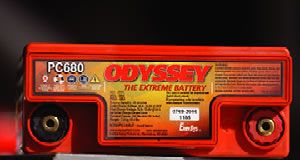Aero ‘lectrics
Dilithium crystals, anyone?
by Jim Weir
In the first place, we have to decide exactly how much electricity we need and in what form we need it. That is, if we are going to go totally solar, the least expensive way to go is with a 12-volt DC system. If we need to go dinoware (gasoline generators), then plain old 110 volts AC will do nicely. If you need to go to 24-volt DC or 220-volt AC systems, then you are out of my class.
To make this determination, lets turn to the folks who have done tons of research on the matter…the automobile industry. It seems the consensus today is a hybrid configuration where we use a DC system for light loads and crank up the internal combustion gasoline sipper for the heavy lifting. The solar-battery system will do nicely for such low-wattage loads as lights, small fractional horsepower motors (Dremel tool size) and the occasional soldering iron. Compressors, drill presses and the like will require that we fire up the dinoware for power. And Id like some method of switching the light loads onto the heavy bus when the generator is running to save the relatively low energy available from the solar-battery system.
Consider Power Requirements
Now that we know how we are going to power our equipment, its time to figure out how much power we need. A good general rule is that for every horsepower of load, you should have at least a thousand watts of generator. Lets figure that a 2-horse compressor will take care of most of the mundane tasks around the shop like filling the tires, running a compression check and a little light paint spraying. This says that a 2-kw generator should take care of the compression stuff. How about drill press and grinder? Now its time to use the old noggin to keep from supersizing the project. Do we simply add the compressor draw to the drill press plus the grinder to size the generator? No. What are the odds of having to run the compressor, drill press and grinder all at the same time? Practically zero. The drill press and grinder both use fractional horsepower motors (or you should buy ones that do have fractional horsepower motors), so the compressor becomes the limiting factor in sizing the generator.
Lets talk about lights for just a minute or two. While the compressor and motor tools will consume the lions share of the peak power, lights will become a significant burden on the electrical system if we don’t watch our power budget. Well talk a bit more about lights in a later chapter of this project, but for now figure that the hangar main lighting will consist of the old standby 4-foot fluorescent consuming about 80 watts. Id really like to be able to see what Im doing, so at first thought six to eight of these fixtures may be necessary. At 80 watts apiece, this is roughly 500 to 700 watts worth of lights. If we are going to run these lights through a 110-volt inverter from the 12-volt solar-battery system, we will be drawing a continuous 40 to 60 amps from the 12-volt battery. Most folks with these small solar systems use a golf cart battery, which is rated at 180 amp-hours at this drain, so you can have your lights on for a little over 3 to 4 hours continuous without any recharge. Again, most of these small systems use a 45-watt solar panel, so to get one hour of 600-watt lights, you need to charge
The battery for 13+ hours worth of sunlight. To get the full 4 hours worth of lights, you need to charge the batteries for 60 hours of sunlight. Or you can add solar panels in parallel to get 90 watts, or 135 watts and so forth. Figure about $4 a watt.
The point is, if you wont use all of those lights, don’t install any more than you need. Use minimum overall shop lighting (just so you don’t trip over the shop cat) and use small drop-cord or desk lights to do the close-up work. Me? Im going to see if I cant get by with about 4 of the new efficient 70watt fixtures and half a dozen 10-watt compact fluorescent bulbs strategically placed in reflector fixtures where I need a really good lighting source. As we will find out in a future column, there are new designs of fluorescent fixtures that give nearly twice the light of a standard shop-light fixture.
The same thing is true for the rest of the stuff Im going to be telling you about. Most of us have grown up in an environment that says if a 10-amp vacuum cleaner is good, a 20-amp is twice as good. I guess it is twice as good…for the electric power company’s stockholders. However, for living on the dangling end of a power shoestring, it behooves us to use the least power we can to get the job done properly.
The other end of that shoestring, though, is not to cut your corners too close. If, for example, you are building a metal airplane that requires you to drive elebendy bazillion rivets, you don’t want to size your compressor so that you drive a rivet, wait for 10 minutes for the pressure to build up, drive another rivet wait another 10 minutes, and so forth.
Worth the Price?
So how much is all of this going to cost? If you are starting from scratch, or if you have to junk some of your high-powered equipment in favor of more modest gear, figure that you will spend the better part of 2 AMUs to get the job done. (An AMU is sometimes used when we don’t want the War Department to know exactly how much we spend on our flying addiction. An Aviation Monetary
Unit is $1000.) The heck of it is that Im using sources for the expensive stuff (compressor, generator, solar panels, batteries) like Harbor Freight, Costco, Sams Club and the other discounters. Lights and fixtures come from the discount home handyman stores such as Home Depot, Lowes and the like. And Im buying the whole lot from scratch. I have too large a compressor, a too-small compressor, old inefficient fluorescent fixtures, no gas generator, no solar panels, no solar controller-regulator and no battery bank.
The one thing I will not discuss in this series of articles is legality. There are more than 3000 counties, 18,000 cities, and heaven knows how many airport commissions in the United States. And to boot, this magazine is worldwide, and I wouldn’t speculate on how many different rules and regulations there are for any given airport anywhere on the face of the planet. Two rules govern almost anything that I do in my own hangar: First, sparks can make a pretty airplane into a pile of scrap metal in a matter of minutes; and second, it is always easier to ask for forgiveness than for permission.
Dont panic if you think Im going to stop with just hand-waving the system design. Far from it. Ill give you the full details in future columns about each of the things Im talking about and sources for the least expensive way of doing it, diagrams of how it all hooks together, and maybe just a little goodie or two to build yourself down the line. However, you can get a good head start on future columns by sitting down right now and making a realistic list of the tools and equipment you’re going to need.
However, for my part, it is time to spend my next four or five paychecks from KITPLANES and buy the stuff Im going to be talking about in the months to come. Stay tuned.













